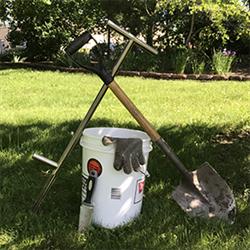Does a doctor write a prescription based on guesses? Of course not. Medication is prescribed only after appropriate consultations, examinations, testing, and diagnosis has taken place.
Do farmers and homeowners fertilize based on guesses? Sometimes, the answer is yes, sadly. And, although the comparison may not be perfect, the concept I’m trying to convey is that a best management practice is to fertilize based on a prescription. Where can we get that prescription? We get it from a soil test.
Whether you are a farmer growing crops or a homeowner growing vegetables or a nice lawn, it's always a good idea to do regular soil testing to gauge nutrient levels, pH, and other factors rather than guess about them.
Most farmers regularly take soil tests to arrive at prescriptive rates of fertilizer or lime that may be needed. Many do so on a grid basis within a field for potentially greater accuracy that can be used to apply fertilizer at variable rates across a field according to soil test results. As expensive as fertilizers are, one can see why a prescription, rather than a guess, can offer economic advantages in the form of cost savings through efficient fertilizer applications.
Similarly, soil testing can also benefit homeowners who care for vegetables, flowers, or their lawn. A representative soil sample taken at least once every 3-5 years will tell you a lot, and may even save you money in the long run.

Soil sampling equipment. Photo by James Wolff.
Without soil test results, landscapers and gardeners may apply fertilizer, lime, or other materials to soils without knowing whether the soils need these amendments or not. Some of these amendments may do more harm than good. In my years as an Extension Educator, I've heard many homeowners play this guessing game. Some of these guesses (especially about amendments that adjust pH), may be exactly the opposite of what is needed. It may also be that certain nutrients are applied that are already abundantly available in the soil.
Critical information homeowners can learn from a soil test are soil pH level, organic matter content, cation exchange capacity (CEC), and phosphorus and potassium levels. Most labs don’t include a nitrogen test because it’s a moving target; soils don’t retain nitrogen, so this nutrient must generally be replenished every year for plants that need it.
Purdue experts Kyle Daniel and Rosie Lerner recently co-authored a publication entitled, “Collecting Soil Samples for Testing,” available at www.edustore.purdue.edu.
“Every soil test should provide you with your soil’s pH, which measures the acidity or alkalinity in your soil,” they said. “Soil pH affects how available most nutrients are for plant uptake.” They said most horticultural plants grow best when the soil pH is between 6.0 and 6.8 (slightly acidic). However, one should research the desired pH level for the plants you grow to see if amendments are needed. For example, potatoes and blueberries prefer an acid soil between 4.5 and 5.1 pH.
“If you need to raise the pH (and make the soil more alkaline), you add lime,” they said. “If you need to lower the pH (and make the soil more acidic), you add sulfur or acidifying nitrogen.”
Fall is generally accepted as a good time to take soil tests in the home landscape or garden. Whenever you decide to test, it’s a good idea to stay with that time to have more of an “apples to apples” comparison with subsequent soil tests.
“The first step of gathering a good soil sample is to draw a diagram of your property and indicate where you will take soil samples from,” they said. “It’s important for you to take samples from different parts of your property that have different characteristics.” For example, you should have different soil tests for your yard, your garden, your flower beds, and your shrub beds.
The publication further explains methods of proper collection of samples for these various areas. In general, samples are taken to a depth that most roots grow within that area. Multiple sub-samples are collected and mixed for one composite sample (one pint) that is sent to the lab.
Soil testing laboratories will be happy to send you sampling bags and sample submission forms (which may also be available online).
Lab reports are reasonably intuitive, but if you need assistance interpreting your results, bring your report to the county Purdue Extension office, and we’ll give you a hand.
A list of certified soil testing labs is available at: https://ag.purdue.edu/department/btny/ppdl/extension/publications.html (see “PPDL-4”).
Soil testing fees are very reasonable. Take the guesswork out of your fertilization and you might save some money in the long run.